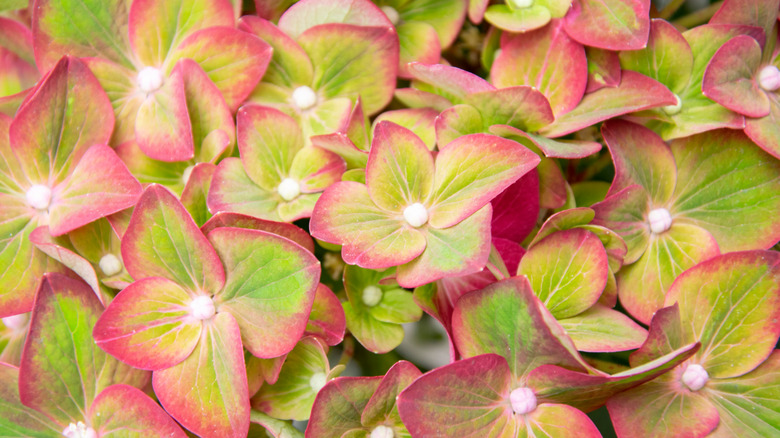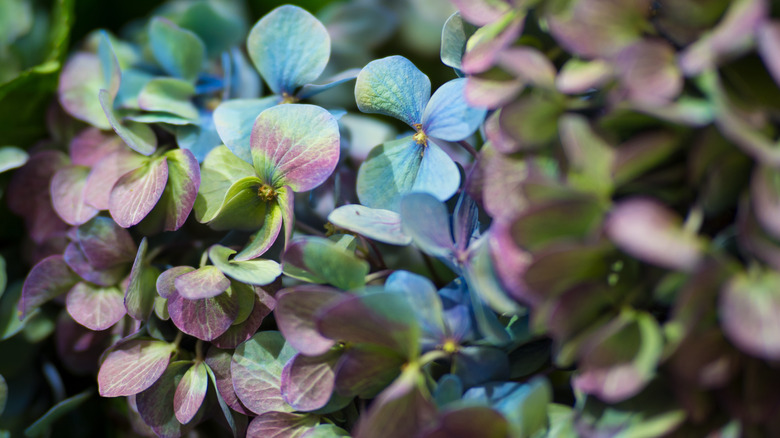You may have seen smaller plants that look like hydrangea but lack the massive scale of the traditional variety. That could be pistachio hydrangea, a much more bush-like, smaller plant that still offers the big, bright blooms many love from the bigger varieties. With a range of colors and clusters of flowers, these plants make a statement when they’re placed in any area. While you can certainly purchase and add them to your garden, it’s illegal to propagate them because they are a patented plant. That means to add more to your yard to create a stunning display of shrubs, you’ll need to purchase another plant from your supplier (aim for a mature variety so that it better matches the size and overall look of the other plants).
As explained, the pistachio hydrangea is a dwarf plant, typically reaching a mature height of about 2 to 3 feet overall. They do spread outwards somewhat, taking up as much as 5 feet of space. You can also keep them pruned well for a more contained look. Though they aren’t likely to be more difficult to grow than most other varieties, there are a few things to consider about these particular varieties to encourage them to develop well. If you’re in hardiness zones 5 to 9, you have the option of planting these hydrangeas in your garden. Keep in mind, though, that they are toxic to pests and people.
What to expect from the pistachio hydrangea

The pistachio hydrangea (Hydrangea macrophylla ‘Horwack’) is a special plant that continues to bloom throughout the season, generally from mid-spring through late into the fall. The coloring is fantastic, with a green and pink combination being a common choice. They don’t require a lot of room, but planting several close to each other in a row creates more of a shrub-like look. They benefit the most from full sun exposure in the morning and do better with some shade at the sunniest point of the day. Place them, for example, along the eastern side of the house so they get enough sun for energy production early in the day before the top temperatures hit.
This plant needs well-draining soil and can be finicky when it comes to balanced soil nutrients. Whenever possible, use a balanced pH soil blend that’s organic. Keep the soil loose around the root system to encourage growth. In addition to this, add a layer of organic mulch along the top to help retain more of the necessary moisture this plant needs. Water often to keep it moist. You can change the color by adjusting the pH balance in the soil.
These plants need a more humid climate than a dry one. However, they require a bit more attention than many other plants when there’s serious weather. Cover them to prevent the loss of petals during storms and protect them over the winter months from being buried under snow.
How to get the most out of pistachio hydrangea

As explained, you cannot propagate them yourself because they are patent-protected. However, with proper placement, you can get a lot of showy blooms out of this plant that make it well worth the investment in your home’s landscape design. You can use them as foundation plants, borders, or statement pieces in your garden beds. They do okay in containers as well, but they need ample water to keep them growing and thriving. You can also use them in your flower garden for cut flowers. They are rebloomers, which means they will continue to come back as you take a few flowers to bring into your yard.
Also, like other hydrangeas, they require some attention to do their best. You’ll want to remove any weak or damaged stems to encourage energy to continue to move towards blooming. Leading up to the winter months, prune them back to help them move into dormancy. You’ll also want to water them significantly a few times prior to this to help stimulate root growth heading into the colder months. Then, use burlap or organic matter to protect your hydrangeas.
Finally, make sure to monitor your plants throughout the season for the risk of pests. They may struggle with Japanese beetles and aphids, and using a natural pest deterrent for your garden is best. Monitor for any signs of mildew on their leaves and stems and provide treatment as quickly as possible if spotted.



